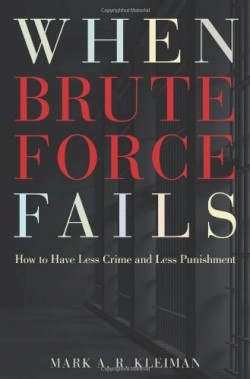When Brute Force Fails
How to Have Less Crime and Less Punishment
Crime and punishment are such emotional issues in America that it’s difficult to view them in an objective cost vs. benefit context. But that’s what Kleiman, a professor of public policy at the University of California, Los Angeles, does. He brings to his analysis a formidable array of statistics and case studies, which, fortunately for the reader, he uses to illuminate rather than overpower.
Kleiman concedes that fear of a certain level of crime is realistically rooted and that society has the right and duty to protect itself. The question, he says, is whether the present law and order system-with its elements of misperception, vengeance, frustration, demagoguery, racism, and political and economic opportunism-does the job society wants it to do for a fair price. He says it does not.
At any given time, Kleiman points out, America has approximately 2.3 million adult offenders behind bars, a rate of 700 for each 100,000 of the population. “Beyond some level-and we may well have passed that level,” he says, “the scale of imprisonment can generate so many perverse effects that additional incarceration becomes, on balance, a contributor to the problem rather than a solution.”
Some of those “perverse effects” are obvious-such as the rise of for-profit prisons with their built-in interest in having more rather than fewer “clients”-but other effects are more subtle. Besides the social and economic harm it may do to a convicted person’s family (and the community at large), prolonged incarceration will almost certainly make the person less employable after he or she is released and, thus, more prone to re-engage in criminal activity.
But Kleiman is no bleeding heart. He argues for less crushing but more certain jolts of punishment early in an offender’s criminal trajectory. The unpleasant experience of repeatedly spending short times in jail for what are now considered minor transgressions, he shows, can do more to condition a person against committing major offenses than the mere threat of facing long-term imprisonment some time in the distant future. Kleiman calls for more coordination among police, probation officers, and courts to nip criminal conduct in the bud.
Having dissected the problem as he sees it, Kleiman offers in his final chapter a series of tips he believes will reduce both crime and the cost of correction and punishment. It is a trenchantly-stated starting point for reformers and fiscal conservatives alike.
Disclosure: This article is not an endorsement, but a review. The publisher of this book provided free copies of the book to have their book reviewed by a professional reviewer. No fee was paid by the publisher for this review. Foreword Reviews only recommends books that we love. Foreword Magazine, Inc. is disclosing this in accordance with the Federal Trade Commission’s 16 CFR, Part 255.

